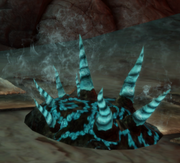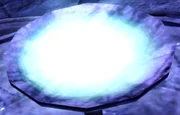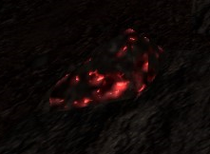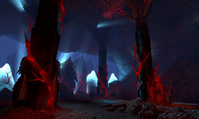No edit summary |
|||
| Line 3: | Line 3: | ||
[[File:Lyrium vein.png|thumb|Lyrium in its raw form]] |
[[File:Lyrium vein.png|thumb|Lyrium in its raw form]] |
||
| − | '''Lyrium''' is a valuable but dangerous mineral. Physical contact with the raw ore will cause serious injury and psychological problems for [[human]]s or [[Elf|elves]] and will kill [[mage]]s outright. The [[Miner caste]] of the [[Dwarf|dwarves]] is able to find lyrium [[Lyrium vein|veins]] by ear<ref name="codex">[[Codex entry: Lyrium]]</ref> as they claim that they hear [[the Stone]] sing.<ref>[[Codex entry: The Crosscut Drifters]]</ref> Then the [[caste]] processes the ore into a less dangerous and more useful form. Generations of proximity to lyrium ore veins have made dwarves naturally resistant, though not completely immune, to its effects. Even their resistance is only skin deep, as open cuts and direct exposure to the eyes leaves them vulnerable. [[Surface dwarves]] lose this resistance over time. |
+ | '''Lyrium''' is a valuable but dangerous mineral like lifeform. Physical contact with the raw ore will cause serious injury and psychological problems for [[human]]s or [[Elf|elves]] and will kill [[mage]]s outright. The [[Miner caste]] of the [[Dwarf|dwarves]] is able to find lyrium [[Lyrium vein|veins]] by ear<ref name="codex">[[Codex entry: Lyrium]]</ref> as they claim that they hear [[the Stone]] sing.<ref>[[Codex entry: The Crosscut Drifters]]</ref> Then the [[caste]] processes the ore into a less dangerous and more useful form. Generations of proximity to lyrium ore veins have made dwarves naturally resistant, though not completely immune, to its effects. Even their resistance is only skin deep, as open cuts and direct exposure to the eyes leaves them vulnerable. [[Surface dwarves]] lose this resistance over time. |
== Adverse Effects == |
== Adverse Effects == |
||
Revision as of 01:22, 23 November 2014
- For the crafting resource in Dragon Age II, see Lyrium (crafting resource).

Lyrium in its raw form
Lyrium is a valuable but dangerous mineral like lifeform. Physical contact with the raw ore will cause serious injury and psychological problems for humans or elves and will kill mages outright. The Miner caste of the dwarves is able to find lyrium veins by ear[1] as they claim that they hear the Stone sing.[2] Then the caste processes the ore into a less dangerous and more useful form. Generations of proximity to lyrium ore veins have made dwarves naturally resistant, though not completely immune, to its effects. Even their resistance is only skin deep, as open cuts and direct exposure to the eyes leaves them vulnerable. Surface dwarves lose this resistance over time.
Adverse Effects

Lyrium in liquid form
Even though dwarves have a natural resistance, raw lyrium is dangerous for all but the most experienced of the Mining Caste to handle. Even for dwarves, exposure to the unprocessed mineral can cause deafness or memory loss. For humans and elves, direct contact with lyrium ore produces nausea, blistering of the skin, and dementia. Mages cannot even approach unprocessed lyrium. Doing so is invariably fatal.[1]
In its processed form, lyrium may be handled by anyone, but long term exposure or a single mistake while working with it can lead to serious side effects. Prolonged use becomes addictive, the cravings unbearable. The effects of lyrium addiction for templars include paranoia, obsession, and dementia.[3] Over time, templars grow disoriented, incapable of distinguishing memory from present, or dream from waking. They frequently become paranoid as their worst memories and nightmares haunt their waking hours. Mages have additionally been known to suffer physical mutation.[1]
Uses

Raw lyrium in Dragon Age II
Processed lyrium is used by dwarves and the Tranquil to enchant items. When mixed into liquid and ingested, lyrium allows mages to enter the Fade when fully aware, unlike all others who reach it only when dreaming. This unique property is essential for the Circle of Magi's Harrowing rituals. Such potions can also be used to aid in the casting of especially taxing spells, for a short time granting a mage far greater power than the mage normally wields.[1] Mages can also be branded with lyrium to become Tranquils, forever severing their connection to the Fade.[4] While mages use lyrium in their arcane spells and rituals, templars ingest the primordial mineral to enhance their abilities to resist and dispel magic.[3]
Lyrium is used by the Chantry to control the templars. Templars are given lyrium to "develop their talents" (though Alistair seems to doubt whether it actually has any real effect), which also leaves them addicted and thus within the control of the Chantry, which controls the lyrium trade.
Trace amounts of lyrium can be infused in stones to create glowstones, which are used to light passages. This practice is most common in Orlais.[5][6]
The smiths of Amgarrak, under the jurisdiction of a Tevinter mage, created strange contraptions known as lyrium wells, capable of shifting objects and people through different levels of the Fade and creating runic golems. However, this was used against them when one of their experiments created a monstrosity capable of manipulating the Wells. After realizing what their creation was capable of, the smiths were forced to seal the thaig to make sure that it wouldn't be able to escape.
In the Fade, the Warden encounters a resource called "raw lyrium" that can replenish all health, stamina, and mana. This also is present at Anvil of the Void, though the effect is lesser, and has no effect on dwarf characters.

Fenris uses his lyrium tattoos
Fenris has lyrium-infused tattoos, which, when used, grant him the ability to phase through solid objects, an act that taps into the Fade. The lyrium tattoos greatly enhance Fenris's warrior talents, making him hard to track, giving him magic resistance, and generating bursts of damaging spirit energy. The process of putting lyrium under his skin was so agonizing that by the time the procedure was complete, Fenris had total amnesia. Fenris claims it is physically painful for his markings to be touched.
Red lyrium
A cavern with veins of red lyrium[7]
Red lyrium is a rare, more potent and more addictive form of raw lyrium created when normal lyrium is corrupted by the Darkspawn Taint. It can be handled by anyone and apparently, does not require dilution and ingestion to take effect. All that is required is to be near the mineral.
Red lyrium has the ability to grant certain magical abilities that are unique. For example, it is known to grant the ability to animate objects and even the power to make things float. It also seems to enhance templar and physical abilities and when processed into a Primeval Lyrium Rune, it will increase a weapon's attack speed.
Eventually though, long term exposure to red lyrium drives all of its users insane. This madness affects even normally resistant dwarves. The symptoms seem to vary. For some, they are driven to madness by a 'song' which compels them to try to force others to hear it; usually through depraved means. For others, their penchant for violence and paranoia are exacerbated. Physical changes also emerge such as red lyrium veins appearing on the skin or the mineral starts growing on the body. If abused too much, the red lyrium will shatter in their hands and cause their body to become petrified. It is also known to thin the Veil, allowing Spirits and apparitions to interact with the physical world.[8]

Meredith's red lyrium-infused sword
A red lyrium idol was worshiped by the inhabitants of an ancient thaig thousands of years ago. Even before the rise of the darkspawn, contact with the thaig was somehow lost, and it could not be resumed because of the arrival of the darkspawn.
In 9:31 Dragon, an expedition into the Deep Roads rediscovered this thaig. The expedition was led by the two dwarven brothers Bartrand and Varric Tethras and the human Hawke. While exploring the thaig, Hawke and Varric found the idol. When they showed it to Bartrand, he betrayed them and stole the idol intending to sell it for a fortune and left them to die within the thaig. In the following years, as a result of prolonged exposure to the red lyrium idol, Bartrand gradually succumbed to insanity.
The idol ended up in the hands of Knight-Commander Meredith Stannard who forged a sword from it. She was corrupted by its power and died during the Kirkwall Rebellion in 9:37 Dragon, petrified in red lyrium after a failed attempt to draw more power from the sword.
In the aftermath of the destruction of the Temple of Sacred Ashes, red lyrium began appearing all over southern Thedas. A splinter faction of the Templar Order, calling themselves the Red Templars, begin to consume red lyrium, corrupting their bodies and transforming themselves into monsters.
According to Bianca Davri's research, red lyrium is lyrium corrupted by the Blight. This proves that lyrium is alive as the Blight can only taint living things.[9] In In Hushed Whispers, it is also shown red lyrium can "infect" the landscape and grow into massive deposits if the Breach becomes wide enough, presumably due to the influence of Corypheus.
Notes
- Deep mushrooms often grow near lyrium veins.[10]
- The glowing slime is an animal living underground which leeches lyrium from the walls allowing it to develop a substance which disorients its prey as well as giving this animal a distinctive blue-green color.
- Beneath the Frostback Mountains there are rich deposits of lyrium veins which have been mined by the dwarves of Orzammar for many millennia.
Trivia
- Effects of lyrium addiction were intended to be implemented in Dragon Age: Origins for mage and templar companions and the use of lyrium potions would have diminishing returns. However, this was ultimately dropped because most characters would need to drink lyrium potions to remain effective, guaranteeing addiction, and the developers couldn't find a way to implement addictions in a way that was neither meaningless nor excessively punishing.[11]
- In Dragon Age: Origins - Awakening, Justice also claimed that his lyrium ring, a gift from the Warden-Commander, has a beautiful song which he wishes his spirit brethren were able to hear.
- In Dragon Age: Asunder, Cole is also able to hear the music when the mages use lyrium for a ritual to enter the Fade, while Adrian hears it when they awaken, leaving the Fade.
- The ashes of the prophet Andraste have the miraculous powers of healing, but Oghren believes the lyrium veins in the temple's wall are richer and purer than anything he has sensed in a while, and that it is changing the building and everything in it.[12] However, according to Chantry legends, Havard experienced the healing effects of the ashes before they were taken to the temple.[13]
- Red lyrium is described as being an anti-magic substance, an opposite force to regular lyrium.[14]
Gallery
See also
References
|
| ||||||||||||||||||||
| ||||||||||||||||||||||||



